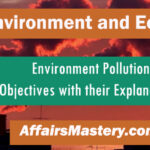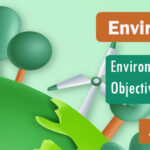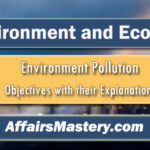Set 2 | Important Environment Issues MCQs
Important Environment Issues MCQs. Environment Issues are pivotal aspects of Environment and Ecology, serving as a cornerstone for success in competitive exams like Civil Services, State exams, SSC, Railways, Banking, and more. Mastering these subjects offers a unique advantage, allowing you to gain invaluable insights into the country’s environmental legacy. With a focus on Environment, Biodiversity, and Ecology, this knowledge not only sharpens your competitive edge but also equips you to excel in these challenging exams.
| MCQs on Environment Issues – Objective Questions and Answers |

Q12. As per the State of India’s Environment (SoE)- 2022 released by Centre for Science and Environment; India recorded 280 heatwave days across 16 states in 2022 — most in the decade. In the context of this, look at the following statements:
- Low Pressure on the earth’s surface causing above air to come down which cause the air warms up and heat waves are generated.
- Marine heat waves over Indian Ocean are caused due to high solar radiation and strong winds.
- New Delhi is the first South Asian city to develop and implement a city-wide heat health adaptation.
Which of the statements given above are incorrect?
[A] 1 and 2 only
[B] 1 and 3 only
[C] 2 and 3 only
[D] All of the above
View Explanation
Correct Answer is D.
- Incorrect Statement 1: Heat waves are caused by anticyclonic conditions (high pressure), which force air to sink, compress, and heat up, leading to hot, dry weather, particularly in India from March to June. Other factors include weak western disturbances and urban heat islands.
- Incorrect Statement 2: Marine heat waves in the Indian Ocean are due to weak winds that reduce evaporative cooling and ocean heat transport, increasing solar radiation. Additional causes include rising sea surface temperatures, El Niño events, and climate change.
- Incorrect Statement 3: Ahmedabad, India, was the first South Asian city to implement a heat health adaptation plan in 2013 after a severe heatwave in 2010. This approach has since expanded to 23 states, covering over 130 cities and districts.
Q13. Which of the following has/have been labelled as the ‘Forever Chemicals’?
[A] Dichlorodiphenyltrichloroethane (DDT)
[B] Carbon dioxide
[C] Chlorofluorocarbons
[D] Perfluoroalkyl and Polyfluoroalkyl Substances
View Explanation
Correct Answer is D.
Option D is correct: A study in Environmental Science and Technology revealed that rainwater worldwide contains PFAs (per- and polyfluoroalkyl substances), known as “forever chemicals” due to their persistence in the atmosphere, rainwater, and soil.
- PFAs (Per- and Polyfluoroalkyl Substances) are man-made chemicals used in nonstick cookware, water-repellent clothing, stain-resistant fabrics, cosmetics, and firefighting foams. They contaminate soil, water, and air during production and use, remaining in the environment for long periods. A study found these chemicals in animals globally, except in Antarctica.
- Usage: PFAs are non-stick, stain, and heat repellent, found in products like food packaging, electronics, and firefighting foams. They are also used in industrial processes like metal finishing, plating, and semiconductor manufacturing. PFAs were used in Teflon production.
- Health Impact: “Forever chemicals” can disrupt key metabolic processes in children and teens.
Q14. Consider the following statements regarding Fly Ash:
- Fly ash It is a fine powder with substantial amounts of oxides of silica, aluminum and calcium.
- New Fly Ash Utilization rules aim to achieve 100% utilization of fly ash in 10 years.
- Under new rules, non-compliant power plants will be imposed with an environmental compensation of Rs 1,000 per tons on unutilized ash during the end of every financial year.
Which of the statements given above are correct?
[A] 1 and 2 only
[B] 2 and 3 only
[C] 1 and 3 only
[D] 1, 2 and 3
View Explanation
Correct Answer is C.
- Correct Statement 1: Fly ash, a by-product of coal-based power generation, contains oxides of silica, aluminum, calcium, and traces of harmful elements like arsenic and lead, leading to air and water pollution if not properly managed. India’s coal has high ash content (30-45%) compared to imported coal (10-15%). With 55% of India’s power generated from coal and lignite-based thermal power plants, fly ash production is substantial, with 83% being utilized.
- Incorrect Statement 2: The first fly ash notification in 1999 aimed for 100% utilization by 2009. A similar notification followed in 2016. The current goal is to achieve full utilization within 3 to 5 years.
- Correct Statement 3: New rules impose an environmental compensation of Rs 1,000 per ton of unutilized fly ash on non-compliant power plants at the end of each financial year. The Central Pollution Control Board collects the fines, and the Ministry of Environment, Forests, and Climate Change (MoEFCC) has extended fly ash utilization deadlines with penalties for non-compliance.
Q15. Prakriti is a mascot launched by the Ministry of Environment, Forest & Climate Change to spread greater awareness among masses regarding:
[A] Natural farming, Organic farming and Organic foods
[B] Sustainable lifestyle for a better environment
[C] Conservation of wildlife and endangered species
[D] Rainwater harvesting
View Explanation
Correct Answer is B.
Option B is correct: The Union Environment Minister launched ‘Prakriti,’ a mascot aimed at raising awareness about adopting sustainable lifestyle changes for a better environment.
- Prakriti will also educate people about green initiatives by the Ministry of Environment, Forest and Climate Change, and the Central Pollution Control Board (CPCB) for effective plastic waste management in India.
- The launch of the ‘Prakriti’ mascot aligns with India’s pledge to eliminate single-use plastics by 2022.
- India generates about 5 million tons of plastic waste annually, with per capita plastic waste nearly doubling in the last five years.
- The IPCC Sixth Assessment Report (AR6) emphasizes mitigation measures to meet Plastic Waste Management goals.
Q16. Consider the following statements regarding Shunya Labelling Programme:
- The Shunya programme for Net Zero Energy Buildings (NZE(B) and Net Positive Energy Buildings (NPE(B) was launched by Ministry of New and Renewable Energy.
- A net-zero energy building is one that relies on renewable sources to produce as much energy as it uses, usually as measured over the course of a year.
- For Shunya labelling, Central Electricity Authority will verify the data and after the assessment, appropriate certificate and plaque will be issued.
Which of the statements given above is/are correct?
[A] 2 and 3 only
[B] 1 only
[C] 2 only
[D] 1, 2 and 3
View Explanation
Correct Answer is C.
- Incorrect Statement 1: The Ministry of Power recently launched the ‘Shunya’ program for Net Zero Energy Buildings (NZEB) and Net Positive Energy Buildings (NPEB). This initiative encourages building owners and developers to create energy-efficient buildings and further enhance them to achieve net zero or net positive energy status.
- Correct Statement 2: Net Zero Energy Buildings (NZEB): These buildings produce as much energy from renewable sources as they consume, typically measured over a year.
- Incorrect Statement 3: For ‘Shunya’ labelling, after submitting the required documents and fees, the Bureau of Energy Efficiency (BEE), under the Ministry of Power, will verify the data. Upon successful assessment, the appropriate certificate and plaque will be issued.
Q17. Consider the following statements with reference to Water Scarcity:
- Due to the Minimum Support Policy, agriculture is resulting in over-exploitation of water.
- Since 2012, the water crisis has consistently been ranked as one of the threats with the highest potential impact as well as likelihood, according to The Global Risk Report.
- As per the report released by the Department of Water Resources in June 2019, India is facing the worst-ever water crisis in history.
- To address the issue, the government is using the Mahatma Gandhi National Rural Employment Guarantee programme.
Which of the statements given above are correct?
[A] 1, 2 and 4 only
[B] 1, 3 and 4 only
[C] 2, 3 and 4 only
[D] All of the above
View Explanation
Correct Answer is A.
- Correct Statement 1: Overuse of water resources and reduced supply due to climate change are pushing India towards water scarcity. Government policies, especially in agriculture (like minimum support price), have led to over-exploitation of water, making India a water-stressed economy. Sustainable water use requires cooperative federalism and citizen activism.
- Correct Statement 2: Water scarcity can trigger forced migration and domestic or regional conflicts, especially in geopolitically fragile areas. Since 2012, the Global Risks Report by the World Economic Forum has consistently ranked water crises as a top threat.
- Incorrect Statement 3: According to a 2019 NITI Aayog report, 600 million Indians face high to severe water stress. The report warns that by 2020, 21 cities could run out of groundwater, and by 2030, 40% of the population may lack access to drinking water, leading to a 6% loss in GDP by 2050.
- Correct Statement 4: Government steps to address water issues include:
- MGNREGA for water conservation: Utilizing the workforce under this scheme to improve groundwater harvesting and build water conservation systems.
- Jal Kranti Abhiyan: Block-level water conservation schemes, including the Jal Gram Scheme to develop model villages in water-scarce areas.
- National Water Mission: Aiming to conserve water, reduce wastage, and promote equitable distribution with a 20% increase in water use efficiency.
- National Rural Drinking Water Programme: Providing safe water to every rural person for basic needs.
- NITI Aayog Composite Water Management Index: Addressing water scarcity and finding ways for effective conservation.
- Jal Shakti Ministry and Jal Jeevan Mission: Tackling water issues holistically and aiming to provide piped water to all rural households by 2024.
Q18. Consider the following statements in context of Green Rating for Integrated Habitat Assessment (GRIHA):
- It is a green building rating system jointly set up by The Energy and Resources Institute (TERI) and the Ministry of New and Renewable Energy (MNRE).
- GRIHA has been developed to rate only the residential buildings in India emphasizing the national environment concerns.
- Global Housing Technology Challenge – India (GHTC- Indi(a) was organised with an aim to identify and mainstream a basket of innovative technologies from across the globe that are sustainable and disaster- resilient.
Which of the statements given above is/are correct?
[A] 1 and 2 only
[B] 2 only
[C] 1 and 3 only
[D] All of the above
View Explanation
Correct Answer is C.
- Correct Statement 1: GRIHA, developed by TERI in collaboration with the Ministry of New and Renewable Energy (MNRE), is a voluntary green building rating system in India. It assesses the environmental performance of a building throughout its life cycle, providing a standard for green buildings and sustainable habitats.
- Incorrect Statement 2: GRIHA is designed to rate commercial, institutional, and residential buildings in India, focusing on national environmental concerns. It serves as a tool to assess building performance against nationally accepted benchmarks.
- Correct Statement 3: The Global Housing Technology Challenge India (GHTC-India) was organized by the Ministry of Housing and Urban Affairs in 2019 to identify and promote sustainable, green, and disaster-resilient construction technologies, aiming to transform housing construction in India.
Q19. Consider the following statements with reference to Green Economy:
- It is defined as low carbon, resource-efficient and socially inclusive.
- It includes a Consumption Linked Incentive for the domestic manufacturing of solar modules.
- The Provision for Introduction of Sovereign Green Bond was laid down in the Budget 2022.
Which of the statements given above are correct?
[A] 1 and 2 only
[B] 1 and 3 only
[C] 2 and 3 only
[D] All of the above
View Explanation
Correct Answer is B.
Correct Statement 1: A green economy is characterized by low carbon emissions, resource efficiency, and social inclusivity. Growth in employment and income in a green economy is driven by investments in economic activities, infrastructure, and assets that reduce carbon emissions, enhance resource efficiency, and prevent biodiversity loss.
Incorrect Statement 2: Key measures for promoting a green economy include:
- Allocation of ₹19,500 crores for the Production Linked Incentive (PLI) scheme to boost domestic solar module manufacturing and achieve 280 GW of solar capacity by 2030.
- Co-firing 5-7% biomass pellets in thermal power plants to reduce carbon emissions and provide farmers with an alternative income source, helping reduce stubble burning.
- Introducing a battery swapping policy for Electric Vehicles (EVs) and emphasizing the development of interoperability standards.
- Budget focus on urban planning, clean technology, and public transport to further boost the EV industry.
- Development of an Energy Service Company (ESCO) model for energy efficiency in large commercial buildings.
Correct Statement 3: In Budget 2022, the finance minister announced the issuance of sovereign green bonds to fund green infrastructure projects. These bonds will raise funds for environmentally and climate-friendly public-sector projects, reducing the economy’s carbon intensity.
Q20. With reference to Geothermal Energy, consider the following statements:
- It is the natural heat from the interior of the earth that can be used to generate electricity.
- In India the southern peninsula is considered a geothermal area.
- Geothermal energy does not pose any environmental problems.
Which of the above statements is/are correct?
[A] 1 only
[B] 2 and 3 only
[C] 1 and 3 only
[D] 1, 2 and 3
View Explanation
Correct Answer is A.
- Correct Statement 1: Geothermal energy is the natural heat from the Earth’s interior, used to generate electricity and heat buildings. This energy is harnessed from areas with volcanic activity, hot springs, geysers, and methane in oceans. The Puga Valley in Ladakh is noted for its promising geothermal potential.
- Incorrect Statement 2: In India, geothermal areas include the Northwestern Himalayas and the western coast. The Geological Survey of India has identified over 350 hot spring sites for potential geothermal energy exploitation. The Puga Valley in Ladakh is noted for its most promising geothermal field.
- Incorrect Statement 3: Geothermal energy can lead to environmental issues, including noise, gas emissions, and disturbances at drilling sites. Steam may contain hydrogen sulfide, causing air pollution with a rotten egg odor, and the minerals can be toxic to fish and corrosive to pipes, necessitating frequent maintenance.
Q21. With reference to Green – Ag Project, consider the following statements:
- It aims to promote organic farming.
- It will be implemented initially in five states in the country.
- It is funded by the Global Environment Facility.
- It aims to cover two protected areas, the Dampa Tiger Reserve and the Thorangtlang Wildlife Sanctuary.
Which of the above statements are correct?
[A] 1, 3 and 4 only
[B] 1, 2 and 4 only
[C] 2 and 3 only
[D] 2, 3 and 4 only
View Explanation
Correct Answer is D.
- Incorrect Statement 1: The project aims to integrate biodiversity, climate change, and sustainable land management into Indian agriculture.
- Correct Statement 2: The Green-Ag Project was launched by the Union government in Mizoram to reduce agricultural emissions and promote sustainable practices. It will also be implemented in Rajasthan, Madhya Pradesh, Odisha, and Uttarakhand.
- Correct Statement 3: The Green-Ag Project is funded by the Global Environment Facility, with the Department of Agriculture, Cooperation, and Farmers’ Welfare (DAC&FW) serving as the national executing agency. The Food and Agriculture Organization (FAO) is an implementing partner, and the Union Ministry of Environment, Forest and Climate Change (MoEF&CC) is involved.
- Correct Statement 4: The Green-Ag Project aims to cover 35 villages and includes two protected areas: Dampa Tiger Reserve and Thorangtlang Wildlife Sanctuary.
Q22. Consider the following statements regarding Ocean Acidification:
- Ocean acidification is the ongoing increase in the pH of the Earth’s oceans, caused by the uptake of carbon dioxide from the atmosphere.
- For marine ecosystems, ocean acidification presents a two-fold challenge of higher acidity and lower availability of carbonate ions.
- Algae and seagrasses may benefit from higher CO2 conditions in the ocean, as they require CO2 for photosynthesis just like plants on land.
Which of the statements given above is/are correct?
[A] 1 and 2 only
[B] 2 and 3 only
[C] 3 only
[D] 2 only
View Explanation
Correct Answer is B.
- Incorrect Statement 1: Ocean acidification is the ongoing decrease in ocean pH due to the absorption of carbon dioxide (CO2) from the atmosphere. Approximately 30–40% of CO2 from human activities dissolves into oceans, rivers, and lakes. Since the industrial revolution, ocean pH has dropped from 8.2 to 8.1 and is expected to decrease by another 0.3 to 0.4 pH units by the end of the century.
- Correct Statement 2: Ocean acidification poses a two-fold challenge for marine ecosystems: increased acidity and reduced availability of carbonate ions. As acidity rises, carbonate ions bond with excess hydrogen, reducing the amount available for calcifying organisms like oysters, crabs, sea urchins, lobsters, and corals to build and maintain their shells and skeletons. These organisms may also experience increased shell dissolution as pH decreases.
- Correct Statement 3: The effects of ocean acidification vary among species. While it negatively impacts organisms like mollusks, corals, and some plankton, some algae and seagrasses may benefit from higher CO2 concentrations, potentially increasing their photosynthetic rates and growth.



